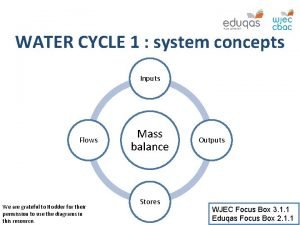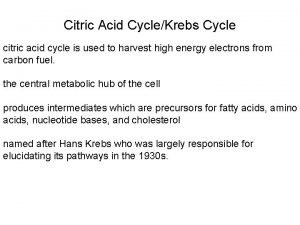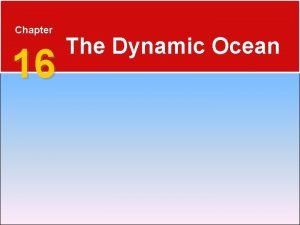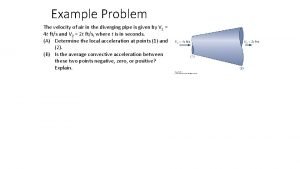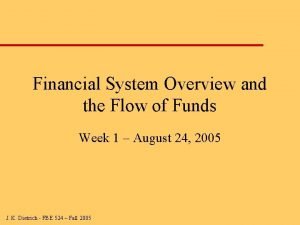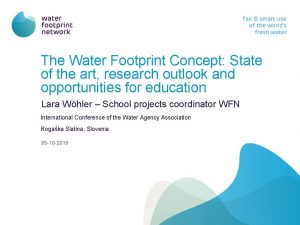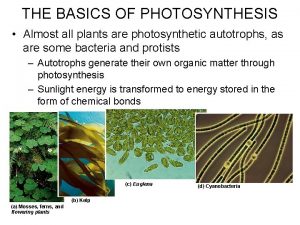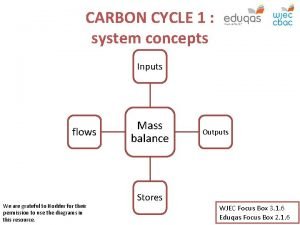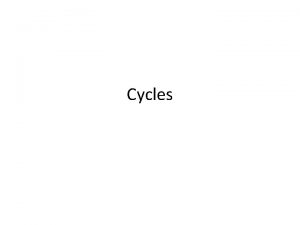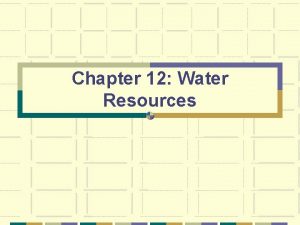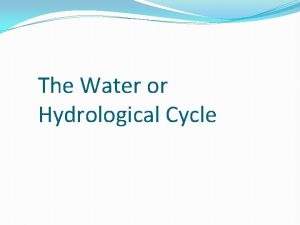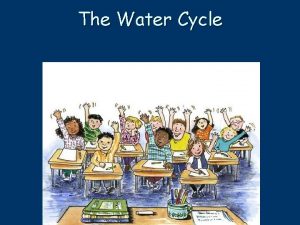WATER CYCLE 1 system concepts Inputs Flows We













- Slides: 13

WATER CYCLE 1 : system concepts Inputs Flows We are grateful to Hodder for their permission to use the diagrams in this resource. Mass balance Stores Outputs WJEC Focus Box 3. 1. 1 Eduqas Focus Box 2. 1. 1

Water Cycle 1 System components • Stores are natural reservoirs of water, such as the ocean, lakes or ice caps • A water flow entering a store is called an input: for example a river entering the ocean • Flows leaving stores are called outputs: for example, evaporation of ocean water • Flows are movements (or transfers or fluxes) between stores in a system Class activity What is the difference between an open system and a closed system? What examples are there of each?

Water Cycle 1 The global water cycle • The global water cycle is shown as a ‘black box’ model • What are the strengths and weaknesses of viewing water stores and flows in this way? Class activity What systems have you studied in other Geography topics? What are their similarities and differences? (c) Hodder Education [OCR A-level Geography (Raw)]

Water Cycle 1 Another view of the water cycle (c) Hodder Education [Edexcel A-level Geography Book 2 (Dunn)] Class activity Which illustration of the water cycle do you prefer, and why?

Water Cycle 1 The concept of mass balance • At a global scale, mass balance means that the total amount of water is always conserved • At the global scale, there is a fixed amount of water in the Earth-atmosphere system (about 1385 million cubic kilometres of water) • Transfers can occur; changes occur in where water is stored without affecting the mass balance. For instance, water vapour in the atmosphere is precipitated on to the land as rain or snow after condensation occurs: although it has changed state, all water still remains in the system Class activity What other water transfer processes are there? Why don’t they affect the system’s mass balance?

Water Cycle 1 Global water stores Store Volume (cubic km) Per cent of total water Distribution and characteristics Oceans 1, 335, 000 97 Oceans cover two-thirds of the Earth Cryosphere 26, 000 2 Groundwater 15, 000 1 Ice and snow stores found at high latitudes (poles) and high altitudes Can remain stored for 10, 000 years River and lakes 178 Soil moisture 122 0. 01 Uneven distribution due to climate Permafrost in Russia and North America Atmosphere 13 <0. 01 Biosphere 0. 6 <0. 01 There is sufficient moisture for ten days of rain in the atmosphere Distributed unevenly because of climate Class activity (1) Compare the size of the different stores (2) What local factors affect water storage in different places?

Water Cycle 1 Investigating the cryosphere • These areas of the Earth where water is present as snow or ice • This includes ice sheets, ice caps, alpine glaciers, sea ice and permafrost (c) Hodder Education [AQA A-level Geography (Skinner)] Class activity Which other Geography topics require you to have knowledge of the cryosphere?

Water Cycle 1 Water store changes • Global hydrological stores change in size over time (seasonal or longer-term) • Both physical and human factors can play a role • For instance, water stored in the Aral Sea has declined markedly since the 1990 s Class activity What factors could explain the changing size of the Aral Sea? (c) Hodder Education [Edexcel A-level Geography Book 2 (Dunn)]

Water Cycle 1 Ice accumulation and ablation • Accumulation is the build-up of snow and ice which takes place within the cryosphere • Ablation is the change from solid ice to liquid or water vapour when temperature rises above 0°C. This wastage of surface snow or ice is achieved by melting and evaporation (the change from ice to vapour is called sublimation) Class activity Use the RGS-IBG interactive resource to explore system changes involving ice accumulation and ablation: http: //www. rgs. org/webcasts/activities/glaciation. html

Water Cycle 1 Changes over time in the cryosphere • Seasonal variations in ice accumulation and ablation bring cyclical fluctuations in water flows and storage in glaciated regions such as the Tibetan plateau • Many cryospheric waters stores are expected to undergo a permanent reduction in size on account of anthropogenic (human-induced) climate change • Longer-lasting changes have occurred naturally in the distant past, including the arrival and departure of glacial and inter-glacial epochs • There are periods in Earth’s past when the planet is believed to have been entirely ice-free Class activity Research (1) Snowball Earth Cryogenian ice ages and (2) Hothouse Earth conditions when the poles were ice-free

Water Cycle 1 Rapid and local transfer processes Precipitation (mm) in Mangalore (India) 1200 1000 800 600 400 200 0 J F MAM J J A S O N D • A monsoon is an especially wet season • In Mangalore in southwest India, more than twothirds of the year’s rainfalls in three months • During the monsoon, rapid water transfers from the atmosphere to the land can take place in just hours or minutes Class activity What is the greatest intensity of rainfall you have ever seen? How much rain can fall in an hour?

Water Cycle 1 Slower global transfer processes • Long-term anthropogenic climate change is projected to impact on water transfer processes globally • Major water transfers from land to the ocean - and accompanying sea level rise - would follow if the Greenland Antarctic ice sheets were to melt • Together, they contain more than 99 per cent of the freshwater ice on Earth. If the Antarctic Ice Sheet melts, sea level will rise by a further 60 metres • However, this would take thousands of years Class activity What is the current rate of global sea-level rise and why is it happening?

Water Cycle 1 Plenary • The global water cycle is a closed system in which all water is conserved over time (mass balance) • Flows in and out of stores are called inputs and outputs • Lakes, oceans, the atmosphere, vegetation, soil and groundwater are water stores, along with the cryosphere (the largest global store of fresh water) • The relative size of ocean and cryosphere storage has altered considerably in the past • Anthropogenic climate change may lead to further changes • Rapid water transfers and storage changes can occur over shorter time scales too, for example the monsoon
 For adult porn
For adult porn Outputs of a drainage basin
Outputs of a drainage basin Water and water and water water
Water and water and water water Inputs and outputs of calvin cycle
Inputs and outputs of calvin cycle Input of citric acid cycle
Input of citric acid cycle Chapter 16 the dynamic ocean
Chapter 16 the dynamic ocean Water flows in the branching pipe shown
Water flows in the branching pipe shown Brain pop water cycle
Brain pop water cycle Water cycle the hydrologic cycle
Water cycle the hydrologic cycle Input output and form design
Input output and form design Flows of funds through the financial system
Flows of funds through the financial system Magneto hydro dynamics power generation ppt
Magneto hydro dynamics power generation ppt Virtual water
Virtual water Inputs of light reactions in photosynthesis
Inputs of light reactions in photosynthesis
